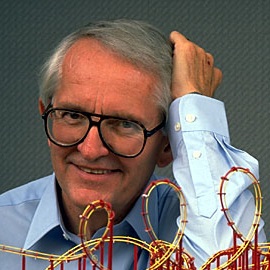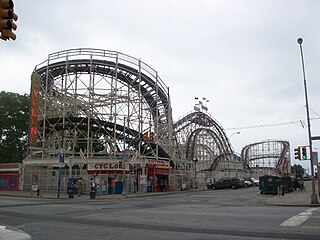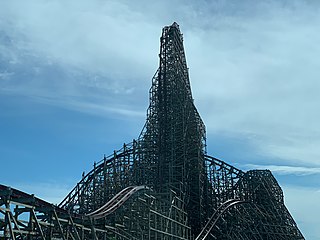
A roller coaster is a type of amusement ride employing a form of elevated railroad track that carries passengers on a train through tight turns, steep slopes, and other elements usually designed to produce a thrilling experience. Trains consist of open cars connected in a single line, and the rides are often found in theme parks around the world. Roller coasters first appeared in the 17th century, and LaMarcus Adna Thompson obtained one of the first known patents for a roller coaster design in 1885, based on the Switchback Railway which opened a year earlier at Coney Island.

A wooden roller coaster is a type of roller coaster classified by its wooden track, which consists of running rails made of flat steel strips mounted on laminated wood. The support structure is also typically made of wood, but may also be made of steel lattice or truss, which has no bearing on a wooden coaster's classification. The type of wood often selected in the construction of wooden coasters worldwide is southern yellow pine, which grows abundantly in the southern United States, due to its density and adherence to different forms of pressure treatment.
A steel roller coaster is a type of roller coaster classified by its steel track, which consists of long steel tubes that are run in pairs, supported by larger steel columns or beams. Trains running along the track typically rely on wheels made of polyurethane or nylon to keep each train car anchored to the track. The introduction of tubular steel drastically changed roller coaster innovation, allowing for greater speeds, higher drops, and more intense elements such as inversions.

A roller coaster inversion is a roller coaster element in which the track turns riders upside-down and then returns them to an upright position. Early forms of inversions were circular in nature and date back to 1848 on the Centrifugal railway in Paris. These vertical loops produced massive g-force that was often dangerous to riders. As a result, the element eventually became non-existent with the last rides to feature the looping inversions being dismantled during the Great Depression. In 1975, designers from Arrow Development created the corkscrew, reviving interest in the inversion during the modern age of steel roller coasters. Elements have since evolved from simple corkscrews and vertical loops to more complex inversions such as Immelmann loops and cobra rolls. The Smiler at Alton Towers holds the world record for the number of inversions on a roller coaster with 14.

Bolliger & Mabillard, officially Bolliger & Mabillard Consulting Engineers, Inc. and often abbreviated B&M, is a roller coaster design consultancy based in Monthey, Switzerland. The company was founded in 1988 by engineers Walter Bolliger and Claude Mabillard, both of whom had worked for Giovanola.

Arrow Dynamics was an American manufacturing and engineering company that specialized in designing and building amusement park rides, especially roller coasters. Based in Clearfield, Utah, the company was the successor to Arrow Development (1946–1981) and Arrow Huss (1981–1986), which were responsible for several influential advancements in the amusement and theme park industries. Among the most significant was tubular steel track, which provided a smoother ride than the railroad style rails commonly used prior to the 1960s on wooden roller coasters. The Matterhorn Bobsleds at Disneyland, built in 1959, was Arrow's first roller coaster project.

The launched roller coaster is a type of roller coaster that initiates a ride with high amounts of acceleration via one or a series of linear induction motors (LIM), linear synchronous motors (LSM), catapults, tires, chains, or other mechanisms employing hydraulic or pneumatic power, along a launch track. This mode of acceleration powers many of the fastest roller coasters in the world.

Ronald Valentine Toomer was an American roller coaster designer credited for designing 93 roller coasters around the world. He graduated from the University of Nevada, Reno in 1961 with a degree in mechanical engineering and was a part of the design team responsible for the Apollo spacecraft heat shield.

A hypercoaster is a roller coaster with a height or drop measuring at least 200 feet (61 m). The term was first coined by Arrow Dynamics and Cedar Point in 1989 with the opening of the world's first hypercoaster, Magnum XL-200, which features a height of 205 feet. The next hypercoaster, Pepsi Max Big One, opened five years later at Blackpool Pleasure Beach featuring a height of 213 feet (65 m).

Green Lantern, formerly known as Chang, is a decommissioned stand-up roller coaster located at Six Flags Great Adventure in Jackson Township, New Jersey. Green Lantern stood 155 feet (47 m) tall and featured a top speed of 63 miles per hour (101 km/h). The 4,155-foot-long (1,266 m) ride featured five inversions and had a duration of approximately 21⁄2 minutes. The steel coaster was designed and built by Swiss manufacturer Bolliger & Mabillard.

Gemini is a racing roller coaster with a wooden structure and steel track located at Cedar Point in Sandusky, Ohio, United States. Built in 1978 by Arrow Dynamics and designed by Ron Toomer, it is one of the oldest roller coasters still operating at the park, with only Blue Streak, Cedar Creek Mine Ride, and Corkscrew being older. Cedar Point marketed the ride as the tallest, fastest, and steepest roller coaster in the world, despite taller and faster coasters that had opened earlier.

An indoor roller coaster or enclosed roller coaster is a roller coaster built inside a structure. The structure may be unrelated to the ride, or it may be intended solely or primarily for the ride. Many indoor coasters are custom made and placed in amusement parks or shopping malls. LaMarcus Adna Thompson, who pioneered the construction of the first simple roller coasters, initially built "scenic railway" rides including "indoor tableaux, panoramas, and biblical scenes illumined by car-tripped switches and flood lamps". A "completely enclosed roller coaster" called the Twister was built as early as 1925. Walt Disney World's Space Mountain was one of the first rides considered to be an indoor roller coaster, and was "the first indoor roller coaster where riders were in total darkness for the length of the ride so they couldn't tell where the drops or turns would occur".

Runaway Mine Train is a steel roller coaster located in the Boomtown section of Six Flags Over Texas in Arlington, Texas. Built in 1966, Runaway Mine Train is the oldest roller coaster in the park.

Ultra Twister was a steel roller coaster located at Six Flags Great Adventure from 1986 to 1988 and then at Six Flags AstroWorld from 1990 until that park was closed and demolished by Six Flags in 2005. The ultratwister-design is that of a pipeline roller coaster, created by Japanese company TOGO.

Roller coaster amusement rides have origins back to ice slides constructed in 18th-century Russia. Early technology featured sleds or wheeled carts that were sent down hills of snow reinforced by wooden supports. The technology evolved in the 19th century to feature railroad track using wheeled cars that were securely locked to the track. Newer innovations emerged in the early 20th century with side friction and underfriction technologies to allow for greater speeds and sharper turns. By the mid-to-late 20th century, these elements intensified with the introduction of steel roller coaster designs and the ability to invert riders.

Rocky Mountain Construction (RMC) is a manufacturing and construction company based in Hayden, Idaho, United States. It is best known for its I-Box track and Topper Track for wooden roller coasters. Founded by Fred Grubb and Suanne Dedmon in 2001, it has built over 20 roller coasters. In 2023, amusement ride manufacturer Larson International merged with it.
Alan Schilke is an American engineer and roller coaster designer based in Hayden, Idaho, United States. He first made his mark on the industry by designing the 4th Dimension roller coaster, X2, while working with Arrow Dynamics. Schilke now works as a design engineer at Ride Centerline LLC and occasionally works with Rocky Mountain Construction (RMC).

A hybrid roller coaster is a category of roller coasters where the track is made out of one material, either steel or wood, and the support structure is made from another. Early hybrid coasters include mine train roller coasters from Arrow Development, which feature a steel track with a wooden support structure. Becoming increasingly more common are hybrids with wooden tracks and steel supports, such as The Voyage at Holiday World.















